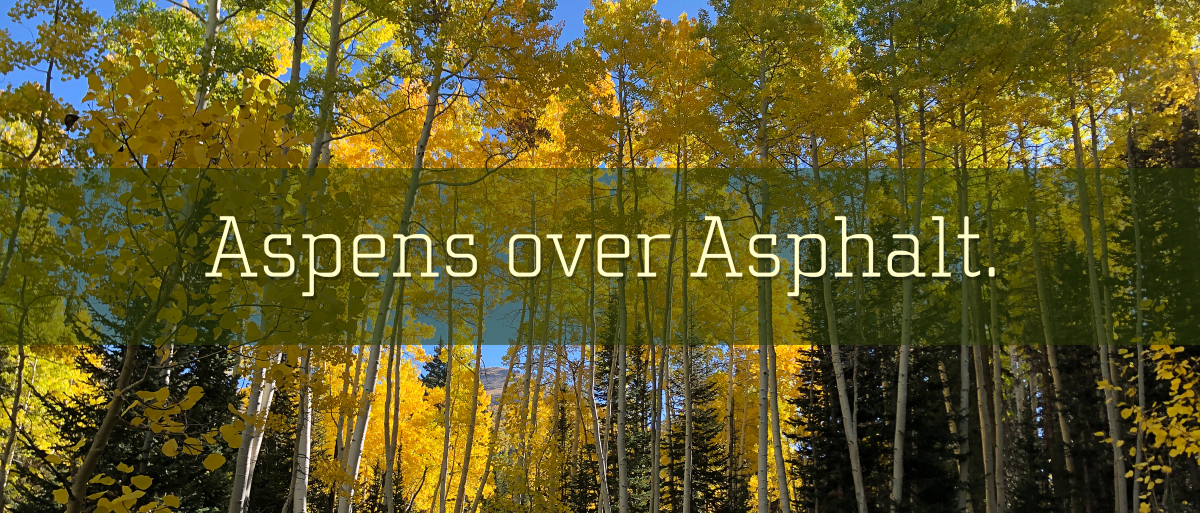Solitude Mountain Resort, under the ownership of Alterra Mountain Company, has submitted a proposal to build a new, paved, 593-space parking lot in Big Cottonwood Canyon (BCC) — directly across SR 190 from Solitude Village.
To do so, they would clear-cut a thriving stand of Quaking Aspen, excavate a steep slope with retaining walls as high as 40 feet, and pave over land perched above Mill F Fork of Big Cottonwood Creek. This project threatens not only the canyon’s scenic character and ecological resilience, but also raises major safety concerns for canyon travelers.
The access road would cross protected watershed lands owned by Salt Lake City Public Utilities (SLCPU), relying on a tenuous claim of a historic jeep trail as legal justification. Meanwhile, the project would create a de facto four-way intersection at a dangerous and already congested section of SR 190, compounding the infamous “red snake” traffic and jeopardizing public safety.
This proposal isn’t about solving parking; it’s about increasing Solitude’s skier capacity. More parking means more traffic, longer lift lines, and more stress on an already overloaded canyon. We acknowledge the need for a transportation solution, but the answer isn’t more parking, more cars, and more development.
Impacts to the Land
This parcel of land is home to a healthy stand of Quaking Aspen, an outstanding natural firebreak, biodiverse habitat, and icon of Big Cottonwood Canyon’s cultural identity. Due to human disturbance and changes in climate, Quaking Aspen populations and overall health have been in decline for decades, leading to increasingly large fires and less diverse habitat. A majority of the canyon is considered “Very High” wildfire risk by the State of Utah’s wildfire risk index, removing this fire resilient species while also introducing more human activity into the area could increase that risk (think - more hot cars and cigarette butts). Below the parking lot is Mill F fork of Big Cottonwood Creek, meaning any development will impact downstream water quality. Though some engineering measures can be taken to reduce impacts to the watershed, any paved surface will inevitably increase erosion, and the extra surface area requiring snow removal will add more salt to the watershed.
Parking, Safety and Congestion
We share common ground with Solitude in the agreement that fewer cars should be parked on the side of the highway, however we drastically differ in proposed solutions (Click here to read our comments on the ongoing BCC Environmental Study). Rather than investing in improved transit solutions to bring visitors to the resort base or implementing skier capacity limits to ease congestion, Solitude has chosen instead to clear-cut a thriving stand of healthy Quaking Aspen to make way for a 593-space parking lot. This short-sighted decision not only sacrifices critical forest habitat, but also undermines opportunities for sustainable, dispersed recreation transportation solutions in the Wasatch. According to the February 2025 Town of Brighton Newsletter, there are 240 roadside parking spaces in inventory along SR 190 between Willow Fork and Brighton resort, meaning that even if all of those spaces were removed, this parking lot would result in a net gain of over 350 spaces. This equation, which also includes Brighton Resort patrons who are unlikely to park so far down the canyon, shows that hundreds of additional parking spaces are not about transportation solutions, but increasing resort capacity. If the goal is to limit congestion and improve safety in the canyon, adding more cars will never be the answer. Furthermore, changes required to make this intersection and pedestrian crossing safe will bring traffic to a stand-still – an ikonic mistake.
The U.S. Forest Service (USFS) regulates visitor capacity in Big Cottonwood Canyon based on available parking. While Solitude claims this simply replaces existing roadside parking, there is no binding guarantee those roadside spaces will be permanently removed.
 Location of the proposed pedestrian crossing
Location of the proposed pedestrian crossing
Questionable Property Access
The proposed parking lot does not border any existing roadways, though there is a small historic jeep track connecting it to Old Stage Road. Old Stage Road itself is a quaint, narrow passage to a few summer homes, and a well-loved track for backcountry recreationists accessing USA Bowl and Willow Fork. The unimproved jeep track which no longer sees motorized use is more akin to a hiking trail. This track connects Solitude’s parcel to Old Stage Road over approximately 150 feet of land owned and preserved by Salt Lake City Public Utilities (SLCPU) to protect water resources. Solitude’s application hinges on the claim that this short, unimproved, rarely used track qualifies for a prescriptive easement. They further claim that it entitles them to build a paved, 2-lane, engineered road switchbacking across over 1,000 feet of this land they do not own on a completely different part of the property.
The Conditional Use Permit Application
Solitude’s initial Conditional Use Permit application for a 720-space parking lot was submitted in February 2025, and determined to be deficient by the Greater Salt Lake Municipal Services District. In April 2025, the resort submitted supplemental materials to address the deficiencies, the updated plan included a survey of the property and slightly smaller lot size.
The Town of Brighton’s code identifies the Planning Commission as the land use authority for conditional use permits. Leading up to and during the hearing, property owners and residents of Brighton will be the primary voice to ensure that this bad project is killed. We anticipate this application to be heard by the Planning Commission in the very near future – there will be a 10-day notice to town residents before the hearing. By state law, the Planning Commission must approve a Conditional Use Permit application if the detrimental effects of the proposal can be “reasonably mitigated” – a term that has an inherent amount of subjectivity. That means this hearing is not about what the community considers favorable, but about the detrimental effects of this proposal, and lack of ability to reasonably mitigate them. The truth is that adding 593 parking spots to the canyon will negatively impact traffic congestion, adjacent parcels, pedestrian safety, fire risk, habitat integrity, water quality, and public land access in ways that cannot be reasonably mitigated.
After the Planning Commission makes their determination, the decision may be appealed to the Land Use Hearing Officer – a likely outcome regardless of the Planning Commission’s determination.
Town of Brighton General Plan
Shortly after the Town of Brighton incorporated, leadership produced the Town of Brighton General Plan with significant community input. This document, published in 2022 and required by state code, acts as a long term planning guide for the town, including the parcel that Solitude intends to build on. The General Plan states that the Planning Commission should use the General Plan "when considering any land use decision as big as the redevelopment of multiple properties or as small as minor design guidelines for a commercial sign. When confronted with a decision that requires the balancing of the rights of a property owner with the overall public interest, this General Plan can assist in weighing the issues and prioritizing what is important.” There are a number of goals in this master plan related to land use, transportation, and natural resources, yet none of them call for additional parking, pavement or cars in the canyon. In fact, many of them point towards minimizing impacts on the environment while maintaining the character of Brighton. Some related goals include:
- LLU1-O1 Restore healthy and resilient trees and forests through land-use regulations.
- LU2-O4 Reduce traffic congestion and increase safety by creating appropriate and sustainable parking standards unique to Brighton’s mix of uses
- T1-O1 Find solutions to provide year-round [transit] service in the canyon.
- T2-O4 Build infrastructure that reduces impacts on wildlife.
- NR1-O4 Preserve open lands that are crucial for wildlife and reduce the potential for open lands to be developed for housing or urban growth.
When characterizing the future of the residential area this parcel is in, the Brighton Town Master Plan states: “This area will see little change in land use over time but may shift focus toward creating safe, environmentally conscious properties that can make the community more resilient”. A 593-space parking lot that removes an entire stand of Quaking Aspen is in direct opposition to this characterization, the overall town vision and specific goals of the Town of Brighton.
Our Ongoing Questions
- The proposed access road and pedestrian crossing are between 2 blind turns, where the current speed limit is 45mph. How would adding this proposed parking lot impact safety and congestion for people accessing the upper canyon? What measures would be taken to mitigate those effects?
- Before determining that more parking was needed, did Solitude attempt to coordinate with UDOT, UTA, and the Town of Brighton to improve transit systems, reducing the number of personal vehicles in the canyon?
- Does a 150-foot historic jeep trail entitle Solitude to build a graded, paved, 2-lane road that would switchback over 1,000 feet of property they don’t own? Could the impacts to neighboring property owners be reasonably mitigated?
- How can the impacts to habitat connectivity, water quality, and wildfire risk caused by paving over a Quaking Aspen stand be reasonably mitigated?
- If this parking lot were built, would the roadside parking used by people accessing public land be removed? Would this lot serve only Solitude customers, or would it be accessible to anyone visiting the canyons for dispersed recreation? And if so, would Solitude charge the public to park on land altered for its private gain?
Our Take
We agree that Highway 190 should not be used as a parking lot—but that’s where our agreement with Solitude ends.
Instead of investing in sustainable year-round transit or placing reasonable caps on daily skier volume, Solitude is proposing to bulldoze a healthy, resilient stand of Quaking Aspen, degrade a critical watershed, fragment wildlife habitat, and pave a new road across land they do not own—all to build a 593-space parking lot. This is not a traffic solution; it’s an expansion plan.
If we’re serious about solving canyon congestion, we must remove cars from the road—not create more reasons for people to drive. Paving over forests to build more parking only invites more traffic, more emissions, and more danger, while locking us deeper into a car-dependent system that clearly isn't working.
This proposal also flies in the face of the Town of Brighton’s General Plan, which calls for restoring forest health, limiting new development, and prioritizing transit-first strategies. The negative impacts—to water quality, fire safety, traffic risk, and the wild character of the canyon—are extensive and irreversible.
We stand with the Brighton community in opposing this reckless and short-sighted project, and we’ll continue to keep you informed on how to get involved and stop this Ikonic mistake.






